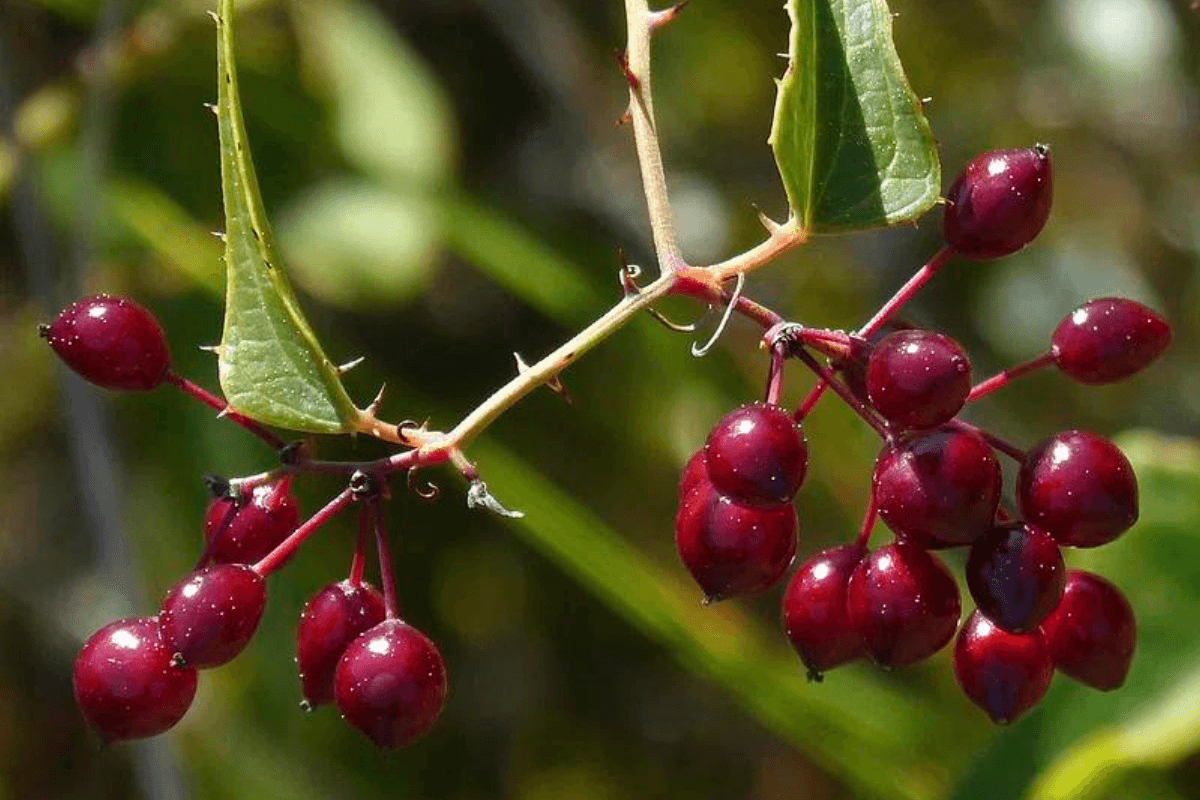Smilax ornata
Sarsaparilla has been used for centuries by the indigenous peoples of Central and South America for sexual impotence, rheumatism, skin ailment, and as a tonic for physical weakness. Sarsaparilla root was used by South American indigenous tribes as a general tonic where New World traders found it and introduced it into European medicine in the 1400s. European physicians considered it an alternative tonic, blood purifier, diuretic, and diaphoretic.
Sarsaparilla root was introduced into European medicine in 1536, where it developed a strong following as a cure for syphilis and rheumatism. Since this time, the Smilax genus has had a long history of use for syphilis and other sexually transmitted diseases throughout the world. With its reputation as a blood purifier, it was registered as an official herb in the U.S. Pharmacopoeia as a syphilis treatment from 1820 to 1910. From the 1500s to the present, Sarsaparilla has been used as a blood purifier and general tonic. And has been used all over the world for the same conditions, namely gout. Syphilis, gonorrhea, wounds, arthritis, fevers, and coughs. Scrofula, hypertension, digestive disorders, psoriasis, skin disease, cancer, and as a tonic.
Organic Sarsaparilla Root Tea – Get Yours Here.
The sarsaparilla plant was first recognized as a pain relief treatment in Peru, where the vine’s extract was used for headaches, joint pain, and ailments associated with the common cold. Additionally, the sarsaparilla plant has been used both internally and externally for leprosy and other skin problems, including psoriasis and dermatitis.
In addition to external uses, the flavonoids in sarsaparilla have been documented to have immune modulation and even live protective activities. A patent was granted in the U.S. in association with sarsaparilla’s apparent effectiveness in treating autoimmune diseases and inflammatory reactions using immunomodulating effects.
Sarsaparilla Root Tincture – Get Yours Here.
The patent includes animal studies that also showed the smilagenin part of the sarsaparilla plant. Reversed the decline of brain receptors in aged mice and restored the receptor levels to those observed in young ones. The animal research also showed that these mice had a reversal in the decline in cognitive function, and enhanced memory and learning. Results of these studies have only been published in the context of the patent so far, and have not yet appeared in any peer-reviewed journals.
Sarsaparilla Root Capsules – Get Yours Here.
Sarsaparilla is now available in a variety of tablets, capsules, and tincture products in many modern natural and health food stores. In addition, sarsaparilla is found as a component ingredient in various herbal remedies made for skin disorders, libido enhancement, hormone balancing, and even sports nutrition formulas.
“This herb is one of nature’s many replacements for COX-2 inhibitor drugs like Vioxx,” said Mike Adams, a holistic nutritionist and proponent of natural medicine. “It reduces inflammation naturally, and unlike prescription drugs, it won’t cause you to have a heart attack and die. That’s important to some consumers and even a few doctors,” Adams said.
Photochemicals:
Aluminum, Ash, Beta-sitosterol, Calcium, Cetyl-alcohol. Chromium, Cobalt, EO, Epsilon-sitosterol, Glucose, Iron. Magnesium, Manganese, Parigenin, Parillin, Phosphorus. Pollinastanol, Potassium, Resin, Saponin, Sarasaponin. Sarsaparilloside, Sarsaponin, Sarsasapogenin, Selenium, Silicon. Sitosterol-d-glucoside, Smilagenin, Smilasaponin, Stigmasterol, Tin, Zinc.
Linking Sarsaparilla to TheHerbProf.com
Sarsaparilla is a versatile herb with a host of medicinal benefits, and at TheHerbProf.com, we’re all about exploring these benefits! Here’s how our website and this subject harmonize:
- Sarsaparilla Saga: We provide comprehensive information about sarsaparilla, its medicinal properties, and its uses in herbal medicine.
- Herbal Highlights: Our site offers insights into how sarsaparilla can be incorporated into your herbal regimen.
- Safety Measures: We guide you on how to use sarsaparilla safely and effectively.
- Health and Wellness: Our focus is on promoting overall health and wellness, and sarsaparilla plays a crucial role in this.
- Community Connection: Connect with others who are interested in sarsaparilla and share your experiences.
So, whether you’re a sarsaparilla enthusiast or just starting your herbal journey, TheHerbProf.com is your trusted guide. Remember, stay curious and stay healthy!
References:
Little Herb Encyclopedia, by Jack Ritchason; N.D., Woodland Publishing Incorporated, 1995
The Ultimate Healing System, Course Manual, Copyright 1985, Don Lepore
Planetary Herbology, Michael Tierra, C.A., N.D., Lotus Press, 1988
Handbook of Medicinal Herbs, by James A. Duke, Pub. CRP Second Edition 2007
The Complete Medicinal Herbal, by Penelope Ody, Published by Dorling Kindersley

